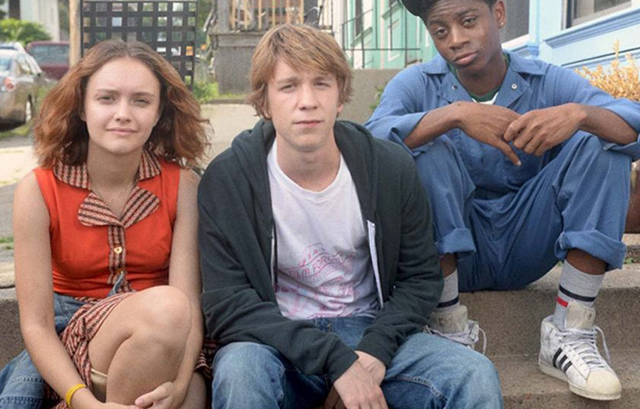CHICAGO – In anticipation of the scariest week of the year, HollywoodChicago.com launches its 2024 Movie Gifts series, which will suggest DVDs and collections for holiday giving.
Ever-Present Passion in ‘Me and Earl and the Dying Girl’
 Rating: 4.0/5.0 |
CHICAGO – There are feelings encoded in a film, imparted by the creators, which sometimes takes a while to become apparent. “Me and Earl and the Dying Girl” is an example, with a deceptive surface story that contains an ocean of feelings and emotions within its passionate core.
The film won both the top jury prize and audience favorite award at the Sundance Film Festival, and brings it into the marketplace five months later with a considerable momentum behind it. That momentum doesn’t do the first part of the film any favors – it is filled with glib high school and adult characters who either act beyond their age or pour too much into stereotypical character traits. But the film clicks into place once all this is established, and becomes a story that touches like a retrieved cherished memory – rooted in the main character’s love of the history of cinema arts. Movies are a fantasy state, that reflect back our hopes and ambitions. With “Me and Earl and the Dying Girl,” all three of the title characters participate in those sensations.
The “Me” in the title is Greg (Thomas Mann), who is about to become a high school senior, and has no particular goal, except to keep hanging out with his best friend Earl (RJ Cyler) and continue to make parody videos of their favorite obscure film titles (think Werner Herzog’s “Fitzcarraldo”). This all changes when he finds out a classmate named Rachel (Olivia Cooke) is dying of leukemia.

Olivia Cooke, Thomas Mann and RJ Cyler of ‘Me and Earl and the Dying Girl’
Photo credit: Fox Searchlight Pictures
Greg’s mother (Connie Britton) implores the teen to “hang out” with Rachel, and he does so reluctantly, because Rachel’s mother (Molly Shannon) maintains an uncomfortable closeness to him. Slowly Greg develops a connection to the Dying Girl, and that affects everything happening around him, including his relationship with his eccentric father (Nick Offerman) and his friendship with Earl.
The description above goes into characteristics because the characters are introduced with their list of “who they are,” and it mixes awkwardly with the story in the first half of the film. The characters felt a bit too “with it,” especially the notion of two 21st Century teenagers knowing the full filmographies of obscure cinema artists, then doing too-coy parodies of them. Molly Shannon and Nick Offerman are fine comic actors, but push the accelerator too hard on their oddball roles initially, and it’s a bit off putting.
However, the three title characters are nicely cast, with Thomas Mann and Olivia Cooke standing out in their subtle portrayals of Greg and Rachel. The rhythms of the film are controlled by Mann’s character, and his laconic nature actually slows down the pacing of the story after the initial tsunami of establishing the characters and their traits. Cooke represents the sadness of her disease, but never lets her guard down in keeping the character noble. RJ Cyler as Earl is harder to pin down, but has a confrontation with his best friend Greg that becomes a significant part of the story.
The screenplay was adapted by Jesse Andrews, who also wrote the source novel, but it is the stardust of director Alfonso Gomez-Rejon that brings the interpretation to life. There are clues and marvels having to do with the history of film that are sprinkled throughout the scenes, with enough references to wear out the pause button on a DVR. It was a bit strange at first, but culminates into a celebration, both as a honor for the emotionally saving grace of movies and a way for the characters to cope with the Dying Girl.

Earl and Greg Share a Meal with Greg’s Dad (Nick Offerman) in ‘Me and Earl and the Dying Girl’
Photo credit: Fox Searchlight Pictures
One of the plot points involves Earl and Greg’s preparation, all through Senior Year, of a film intended to be given to Rachel. The quest is Don Quixote-like, because given the realities of dying and the scope of that consequence, getting lost in such a summation would cripple the greatest filmmakers. How they come through it is the highlight the film, the reason for all that had been built up before it. And suddenly every moment in the film made sense, as what is encapsulated through Greg’s consciousness becomes the dream that we all share.
That is why the movies matter to our 20th and 21st century souls so much. What was invented as a diversion has become a lifestyle, in either creating these dreams or interpreting them as the audience. “Me and Earl and the Dying Girl” shine the lovely images of its own truth, at the perfectly-timed rate of 24 frames per second.
 | By PATRICK McDONALD |


